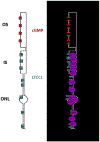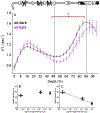MRI of rod cell compartment-specific function in disease and treatment in vivo
- PMID: 26344734
- PMCID: PMC8091657
- DOI: 10.1016/j.preteyeres.2015.09.001
MRI of rod cell compartment-specific function in disease and treatment in vivo
Abstract
Rod cell oxidative stress is a major pathogenic factor in retinal disease, such as diabetic retinopathy (DR) and retinitis pigmentosa (RP). Personalized, non-destructive, and targeted treatment for these diseases remains elusive since current imaging methods cannot analytically measure treatment efficacy against rod cell compartment-specific oxidative stress in vivo. Over the last decade, novel MRI-based approaches that address this technology gap have been developed. This review summarizes progress in the development of MRI since 2006 that enables earlier evaluation of the impact of disease on rod cell compartment-specific function and the efficacy of anti-oxidant treatment than is currently possible with other methods. Most of the new assays of rod cell compartment-specific function are based on endogenous contrast mechanisms, and this is expected to facilitate their translation into patients with DR and RP, and other oxidative stress-based retinal diseases.
Keywords: Animal models; Calcium channels; Diabetes; MRI; Retinitis pigmentosa; Retinopathy; Subretinal space; Vision.
Copyright © 2015. Published by Elsevier Ltd.
Figures











Similar articles
-
Preventing diabetic retinopathy by mitigating subretinal space oxidative stress in vivo.Vis Neurosci. 2020 Jun 15;37:E002. doi: 10.1017/S0952523820000024. Vis Neurosci. 2020. PMID: 32536351 Free PMC article. Review.
-
Antioxidants slow photoreceptor cell death in mouse models of retinitis pigmentosa.J Cell Physiol. 2007 Dec;213(3):809-15. doi: 10.1002/jcp.21152. J Cell Physiol. 2007. PMID: 17520694
-
Oxidative Stress and Microglial Response in Retinitis Pigmentosa.Int J Mol Sci. 2020 Sep 28;21(19):7170. doi: 10.3390/ijms21197170. Int J Mol Sci. 2020. PMID: 32998461 Free PMC article. Review.
-
Rod photoreceptor neurite sprouting in retinitis pigmentosa.J Neurosci. 1995 Aug;15(8):5429-38. doi: 10.1523/JNEUROSCI.15-08-05429.1995. J Neurosci. 1995. PMID: 7643192 Free PMC article.
-
Defining the catalytic activity of nanoceria in the P23H-1 rat, a photoreceptor degeneration model.PLoS One. 2015 Mar 30;10(3):e0121977. doi: 10.1371/journal.pone.0121977. eCollection 2015. PLoS One. 2015. PMID: 25822196 Free PMC article.
Cited by
-
Preventing diabetic retinopathy by mitigating subretinal space oxidative stress in vivo.Vis Neurosci. 2020 Jun 15;37:E002. doi: 10.1017/S0952523820000024. Vis Neurosci. 2020. PMID: 32536351 Free PMC article. Review.
-
OCT imaging of rod mitochondrial respiration in vivo.Exp Biol Med (Maywood). 2021 Oct;246(20):2151-2158. doi: 10.1177/15353702211013799. Epub 2021 May 22. Exp Biol Med (Maywood). 2021. PMID: 34024141 Free PMC article. Review.
-
Genetically heterogeneous mice show age-related vision deficits not related to increased rod cell L-type calcium channel function in vivo.Neurobiol Aging. 2017 Jan;49:198-203. doi: 10.1016/j.neurobiolaging.2016.09.009. Epub 2016 Sep 23. Neurobiol Aging. 2017. PMID: 27823846 Free PMC article.
-
Rod Photoreceptor Neuroprotection in Dark-Reared Pde6brd10 Mice.Invest Ophthalmol Vis Sci. 2020 Nov 2;61(13):14. doi: 10.1167/iovs.61.13.14. Invest Ophthalmol Vis Sci. 2020. PMID: 33156341 Free PMC article.
-
Correcting QUEST Magnetic Resonance Imaging-Sensitive Free Radical Production in the Outer Retina In Vivo Does Not Correct Reduced Visual Performance in 24-Month-Old C57BL/6J Mice.Invest Ophthalmol Vis Sci. 2021 May 3;62(6):24. doi: 10.1167/iovs.62.6.24. Invest Ophthalmol Vis Sci. 2021. PMID: 34036313 Free PMC article.
References
-
- Alder VA, Yu DY, Cringle SJ, Su EN, 1991. Changes in vitreal oxygen tension distribution in the streptozotocin diabetic rat. Diabetologia 34, 469–476. - PubMed
-
- Antonetti DA, Barber AJ, Khin S, Lieth E, Tarbell JM, Gardner TW, 1998. Vascular permeability in experimental diabetes is associated with reduced endothelial occludin content: vascular endothelial growth factor decreases occludin in retinal endothelial cells. Penn State Retina Research Group. Diabetes 47, 1953–1959. - PubMed
-
- Arteel GE, Thurman RG, Raleigh JA, 1998. Reductive metabolism of the hypoxia marker pimonidazole is regulated by oxygen tension independent of the pyridine nucleotide redox state. Eur. J. Biochem 253, 743–750. - PubMed
Publication types
MeSH terms
Substances
Grants and funding
LinkOut - more resources
Full Text Sources
Other Literature Sources
Medical
Miscellaneous

